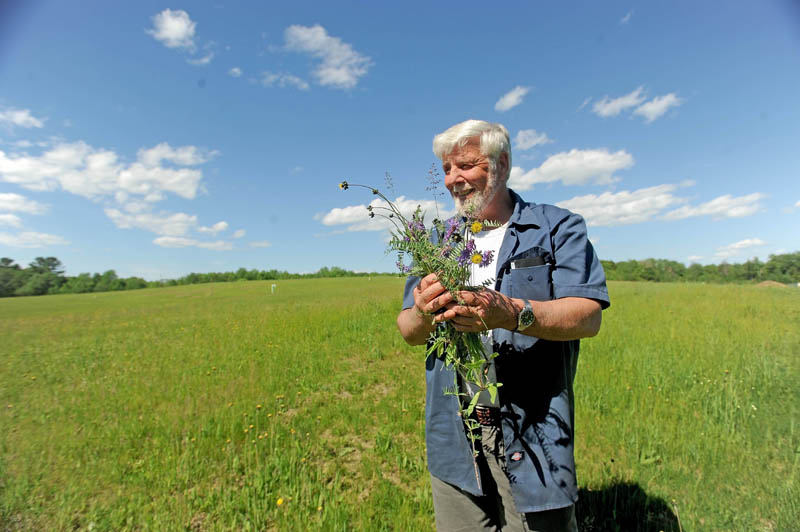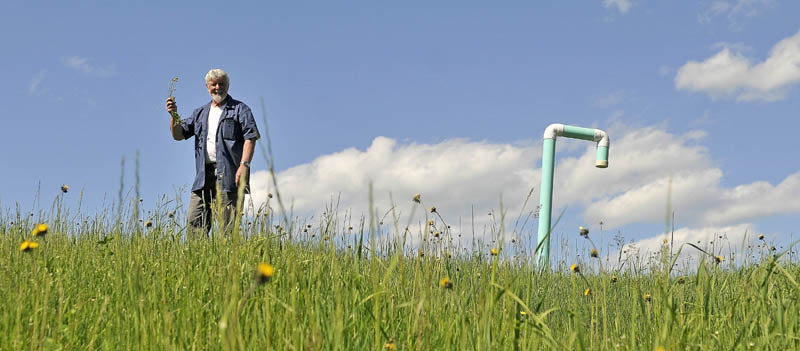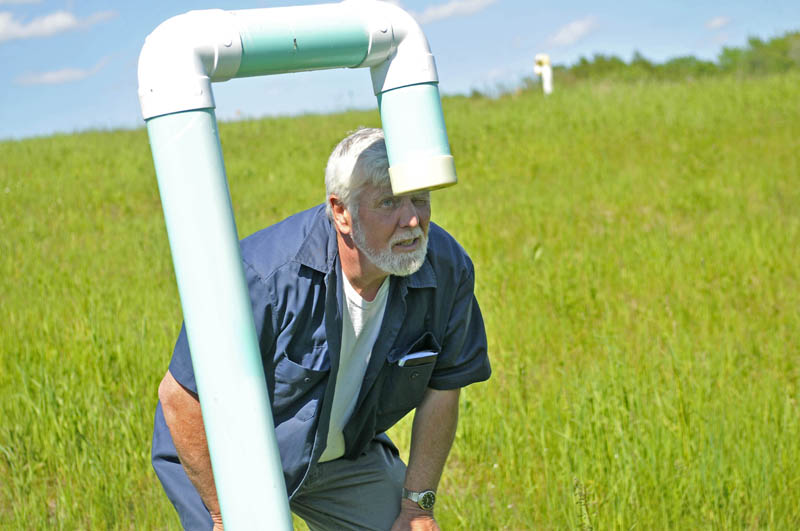OAKLAND — When people refer to the butterfly effect, the idea that the flapping of a butterfly’s wings can cause a chain reaction that can lead to big changes in the world, it’s usually meant as a metaphor.
But one day, late last summer, when the flap of a particular monarch butterfly’s wings carried the delicate creature into the view of Johnny Thomas, the man in charge of Oakland’s trash, the words took on a literal meaning as well.
Thomas, 62, didn’t realize immediately that the butterfly was going to inspire him to expand his duties, beyond sorting and burying and shipping tons of trash at the town transfer station off Town Farm Road. Soon, however, he would be dreaming, not of trash, but of transforming the town’s dump, and dumps across the nation, into colorful wildflower gardens.
When Thomas noticed the butterfly last summer, it made just enough of an impression on him that he kept an eye out for the next one, and the next one after that. During a three-day period, he watched six or eight butterflies flit across the town’s transfer station and landfill property at ground level, ascend to clear a building, then flutter yet higher to continue on, high over the treetops and out of sight.
The monarchs were heading south for the winter, he realized. They were coming from the north, then landing to rest at a small strip of colorful wildflowers among some brush near the edge of the landfill, before resuming their journey.
Not long after that butterfly flapped its wings, Thomas’ dream began to take shape.
“Why couldn’t it all be like that?” he asked, spreading his arms in a gesture that encompassed all 12 acres of the landfill he had watched over for seven years.
Each year, millions of butterflies leave the Northeast for their winter roosting grounds in the fir forests of central Mexico.
If Thomas, an unlikely dreamer, has his way, the town’s garbage-laden landfill will be topped with a massive display of brown-eyed susans, johnny jump-ups, gloriosa daisies, forget-me-nots, purple coneflowers and blue flax — 23 or 25 varieties in all.
Like the butterflies and the hummingbirds that pause in their migration to sip nectar from flowers like the ones he wants to plant, the idea has a certain amount of whimsy.
Living landfills
Thomas, his ruddy, weathered face ringed in white by his hair and close-trimmed beard, has a special sort of reverence for Oakland’s landfill, which looks at first like any other 12-acre, grass-covered hill.
The special circumstances that created the grass-covered dump make it an odd mix of life and death.
“That right there,” Thomas said, “is sacred ground.”
Beneath the unkempt green grass is a layer of topsoil, mandated by the state to be at least 6 inches deep. The grass and topsoil protect a 2-foot-thick layer of clay, an impermeable cap for a mountain of refuse that Thomas said includes automobiles and appliances, mattresses and refrigerators, wood chips and old, rotting food.
John James has been with the Department of Environmental Protection since 1984. In that time, he has seen the state and federal governments spent more than $80 million putting clay caps on Maine’s hundreds of landfills.
James helps oversee state regulation of landfills to prevent water from running through the buried trash. When water does get in, he said, it can leach out metals including iron, manganese and arsenic, and carry it into the ground, contaminating nearby wells and groundwater.
The mountain of trash beneath the grass is hidden, but there are obvious signs that it is there.
Birds perch atop PVC pipes that spew a continuous stream of methane produced by the garbage buried there 23 years ago. Those close enough to a pipe can smell the methane and see it distort the view of what lies beyond, the way heat rising from asphalt does on a summer day.
Thomas said state testing shows salt from the food buried beneath the grass still leaches into a nearby brook. At odd spots in the lush grass, there are brown patches where the methane has seeped up, poisoning the plants atop it.
An unlikely dreamer
By some measure, Johnny Thomas, a blue-collar worker with deep ties to the area, doesn’t seem like the sort to have butterfly dreams.
Not quite comfortable in the digital space inside his computer, he said, he keeps his boot-clad feet firmly planted on real soil. His wristwatch has real arms that crawl through real space, powered by the same kinds of gears he sees in the crushers and heavy machinery he and his workers use to process the town’s garbage.
When talking Thursday, Thomas often gestured with both hands, as if wanting to grasp and fiddle with the abstract concepts he was describing.
Born and raised in Oakland, his speech is thick with the Maine accent of his grandfather, Milo Standish Thomas, a notorious bootlegger who fed the family with game, including does and fawns. Thomas hunts, but he said he inherited a soft spot from his father, John E. Thomas, who taught him not to kill does when furnishing the table.
That soft spot for animals, it seems, is the answer to what has pushed Thomas to take on the task of spreading flowers where they have not grown before. For him, it is a moral question.
“We can give something back instead of take, take, take,” he said.
After seven years alongside the dump, Thomas has trained his kind, gray eyes to scan the landfill for visiting foxes, turkeys, porcupines, hawks, rabbits and woodchucks.
Deer use the landfill as a nursery, he said, taking advantage of the long grass to hide their young. The grass also provides nesting sites for sparrows, one of many species of birds — seagulls, thrushes, redwing blackbirds, starlings, pigeons, and more — that visit or make a living by feasting on the bugs.
Thomas watches over the animals that make their home on or near the landfill. Every year, when young birds fall from nesting sites in the eaves of the transfer station, the workers carefully carry them to wildlife sanctuaries.
He also worries about the bluebirds, which aren’t as common as they were when they had a lot of old farm fence posts to nest in.
The state won’t allow birdhouse posts, which would penetrate the clay cap, so Thomas spent some of his free time welding old bed frames and signposts into heavy bases for four birdhouses that sit on the grass. On Thursday, just days after installing them, a bluebird already had moved into one.
Thomas also asked the town to postpone its annual mowing from early July to late August, after the goldenrod has blossomed and the rabbits and small creatures with nests in the grass have had a chance to rear young.
Now Thomas would like to help the butterflies and hummingbirds, too.
“A monarch coming from Aroostook, headed to Mexico, needs feeding stations,” Thomas said.
Herb Wilson, who teaches ornithology at Colby College, is one of many biologists working to produce a Maine Butterfly Atlas.
Wilson said a floral-topped landfill would help not only migrating monarchs, but also the large majority of butterfly species that live and die within 100 yards of their birthplace.
“They would be more than happy to stop in this cafeteria,” he said. “In terms of flowers, the more the better.”
He said he had heard of butterfly gardens before, but not on a landfill.
A floral experiment
In order for anything to be done on top of a landfill, the state has to be satisfied that it won’t release the contaminants trapped beneath the clay cap.
“We have an $80 million investment in that,” the DEP’s James said. “We don’t want to put something on there that will short-circuit that system.”
When Thomas approached James in late March, James said it was the first time the department had fielded such a request. Usually when he gets calls about regulations, he said, “they want to spread sludge, not plant wildflowers.”
James said the department wants to see whether the wildflower roots will reach the clay and, if they do, whether they will penetrate it or turn to the side and grow laterally.
In May, the department gave Thomas permission to test flowers on a couple of different sites that comprise a half-acre.
Within weeks, the land will be rototilled, sprayed with a pesticide to eliminate the competition, then impregnated with seeds, mostly from The Vermont Wildflower Farm, of Charlotte, Vt., Thomas said.
Then, Central Maine Hydroseeding, an Oakland-based firm donating its services, will spray a cover of wood fiber mulch, fertilizer and water onto the ground to protect the seeds from birds and help them grow.
It will take two years for the experiment to be complete, for all of the perennials, semi-annuals and annuals to have had a chance to bloom.
If it succeeds, the wildflower cover would help both the butterflies and the landfill, James said.
Grass is used now, James said, because it is a cheap and easy solution that does the job of protecting the clay beneath. But the grass is one species, a monoculture that is not ideal for a thriving, diverse ecosystem, he said.
“We’ve just done this one thing, and everyone is used to it,” he said. “Somebody comes up with a new idea and causes us to think.”
If the flowers prove to be more resistant to poisoning from methane gas, he said, they actually could be a more effective solution than grass.
The butterfly effect
At the end of a day at the transfer station, Thomas sat at his desk, littered with wildflower books and seed catalogues, marked heavily with color-coded highlighters to indicate species that might suit the needs of both the state environmental department and the butterflies.
So far, Thomas said, he has received a lot of support. The town’s government has approved the idea, and companies have donated or discounted their services. The Oakland Lions Club donated $1,000 to the cause and is accepting earmarked donations for it, too.
“I’ve done something to make a difference, I hope,” he said.
Once he proves that wildflowers can exist safely on a capped landfill, he said, he will spread the message. Maine’s 400 landfills are just the beginning — there are estimated 560,000 acres of buried garbage nationwide. He wants to reach people in the waste management industry, at statewide conferences and in industry publications, until landfills provide a long chain of migratory butterfly resting spots.
Whether the storm of activity around the idea of planting wildflowers will continue to escalate into a nation-changing tsunami of garbage-covering flowers remains to be seen.
If the vision does come to fruition, however, it can be traced back to that day in late August, when a single flap of the wings of a butterfly carried it across Johnny Thomas’ field of view.
Matt Hongoltz-Hetling — 861-9287
mhhetling@centralmaine.com
Send questions/comments to the editors.




